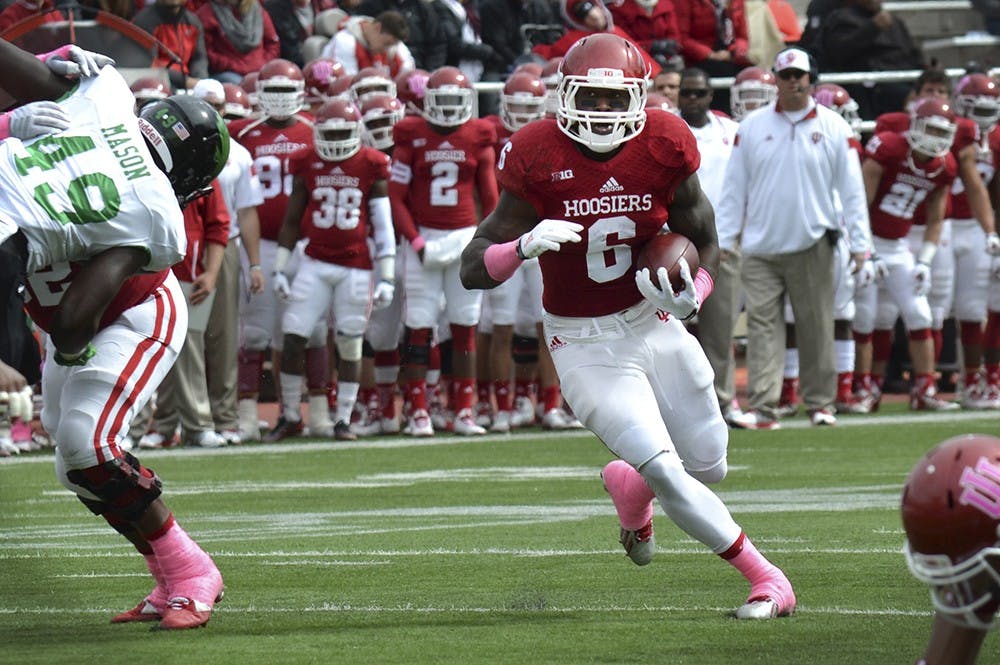Just past the midway point in the season, Coleman has established himself among the nation’s leading rushers. His name has started to be thrown around in various news outlets’ Heisman talks.
Although he’s not listed on ESPN’s official Heisman Watch, he did receive one fifth-place vote.
But soft-spoken Coleman’s emotions have been kept in check, even after being asked about it again after IU’s 56-17 loss to Michigan State.
“If I get it, I get it,” Coleman said. “If I don’t, I don’t. I mean, it’s a real blessing to be in that award ?(consideration).”
Coleman is statistically one of the nation’s elite. He just doesn’t play for an elite team.
As it stands, IU is 3-4 and won’t have junior quarterback Nate Sudfeld available the rest of the season.
The only player to ever win the Heisman off of a losing team was Notre Dame quarterback Paul Hornung in 1956. The Irish went 2-8 that season, beating only IU and North Carolina.
Coleman’s 1,192 rushing yards leads the nation. He’s also added 11 touchdowns.
His per-carry average of 8.8 is on pace to shatter Nebraska’s Mike Rozier’s current record of 7.8 yards per carry.
With five games left to play, Coleman is 11th in IU’s all-time single-season rushing list. He’s only 613 yards from matching Vaughn Dunbar’s record of 1,805 yards.
As the Heisman committee writes, the Heisman is designed to “recognize the outstanding college football player whose performance best exhibits the pursuit of excellence with integrity.”
Translation: the award is designed to go to the best player in the country, not the best player on the best team.
In 1989, IU’s Anthony Thompson finished second in the Heisman race on a 5-6 IU team behind Houston quarterback Andre Ware, who was the first black quarterback to claim the Heisman trophy.
Fans, 54 previous Heisman winners and 840 members of the media vote to determine the Heisman winner. Each voter gets three votes for first, second and third place.
Because IU isn’t routinely on national networks such as ESPN, those 895 voters likely won’t see every IU game unless they happen to have Big Ten Network.
IU’s most recent 56-17 loss to Michigan State was broadcast on ESPN. In that IU loss, Coleman accounted for 62 percent of IU’s yards.
Coleman finished with 132 rushing yards on just 15 carries, becoming the first opposing player to rush for more than 100 yards against the Spartans this season.
Coincidentally, that was a disappointing game by Coleman’s standards. He’s averaging 170 yards per game.
His effort was slightly more impressive considering the Spartans were honest about stacking the box and trying to limit Coleman with true freshman quarterback Zander Diamont, who was making his college debut.
Coleman also opened the field for IU senior Shane Wynn on a reverse that went for 75 yards and a touchdown.
“Everybody followed Tevin,” Wynn said. “He just tossed the ball back to me and I just ran.”
With IU still rediscovering its offensive identity with a new quarterback, Coleman will likely continue to be tested with Penn State and Michigan next on the schedule, two schools that happen to be first and second in rushing defense in the Big Ten.
Penn State’s 61 rushing yards per game allowed is best in the nation.
With that in mind, IU Coach Kevin Wilson said these next few games will test Coleman as teams continue to plan their game around him.
“There’s some really good run defenses, and we are going to be limited because of (our) quarterback,” Wilson said. “But it’s going to take a team effort for him to keep doing what he’s doing.”




